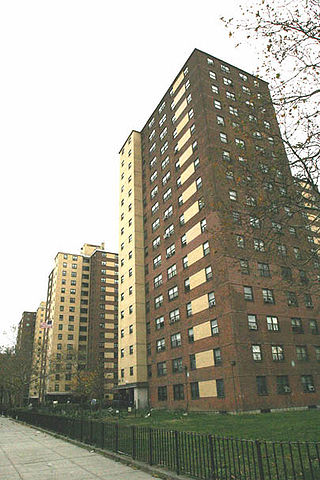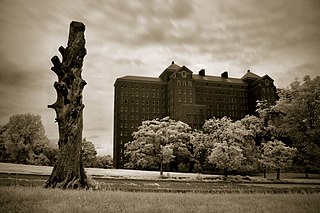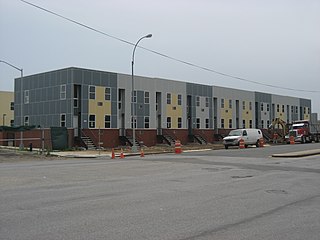
Varicose veins, also known as varicoses, are a medical condition in which superficial veins become enlarged and twisted. Although usually just a cosmetic ailment, in some cases they cause fatigue, pain, itching, and nighttime leg cramps. These veins typically develop in the legs, just under the skin. Their complications can include bleeding, skin ulcers, and superficial thrombophlebitis. Varices in the scrotum are known as varicocele, while those around the anus are known as hemorrhoids. The physical, social, and psychological effects of varicose veins can lower their bearers' quality of life.

Coney Island is a neighborhood and entertainment area in the southwestern section of the New York City borough of Brooklyn. The neighborhood is bounded by Brighton Beach to its east, Lower New York Bay to the south and west, and Gravesend to the north and includes the subsection of Sea Gate on its west. More broadly, the Coney Island peninsula consists of Coney Island proper, Brighton Beach, and Manhattan Beach. This was formerly the westernmost of the Outer Barrier islands on the southern shore of Long Island, but in the early 20th century it became connected to the rest of Long Island by land fill.

Cobble Hill is a neighborhood in the northwestern portion of the New York City borough of Brooklyn. A small neighborhood comprising 40 blocks, Cobble Hill sits adjacent to Brooklyn Heights to the north, Boerum Hill to the east, Carroll Gardens to the south, and the Columbia Street Waterfront District to the west. It is bounded by Atlantic Avenue (north), Court Street (east), Degraw Street (south) and the Brooklyn Queens Expressway (west). Other sources add to the neighborhood a rectangle bounded by Wyckoff Street on the north, Hoyt Street on the east, Degraw Street on the south, and Court Street on the west.

Canarsie is a mostly residential neighborhood in the southeastern portion of Brooklyn, New York City. Canarsie is bordered on the east by Fresh Creek Basin, East 108th Street, and Louisiana Avenue; on the north by Linden Boulevard; on the west by Ralph Avenue; on the southwest by Paerdegat Basin; and on the south by Jamaica Bay. It is adjacent to the neighborhoods of East Flatbush to the west, Flatlands and Bergen Beach to the southwest, Starrett City to the east, East New York to the northeast, and Brownsville to the north.

Bushwick is a neighborhood in the northern part of the New York City borough of Brooklyn. It is bounded by the neighborhood of Ridgewood, Queens, to the northeast; Williamsburg to the northwest; East New York and the cemeteries of Highland Park to the southeast; Brownsville to the south; and Bedford–Stuyvesant to the southwest.

East New York is a residential neighborhood in the eastern section of the borough of Brooklyn in New York City, United States. Its boundaries, starting from the north and moving clockwise, are roughly the Cemetery Belt and the Queens borough line to the north; the Queens borough line to the east; Jamaica Bay to the south, and the Bay Ridge Branch railroad tracks and Van Sinderen Avenue to the west. Linden Boulevard, Pennsylvania Avenue, and Atlantic Avenue are the primary thoroughfares through East New York.

Brownsville is a residential neighborhood in eastern Brooklyn in New York City. The neighborhood is generally bordered by Crown Heights to the northwest; Bedford–Stuyvesant and Cypress Hills to the north; East New York to the east; Canarsie to the south; and East Flatbush to the west.

The Kings Park Psychiatric Center, known by Kings Park locals as "The Psych Center", is a former state-run psychiatric hospital located in Kings Park, New York. It operated from 1885 until 1996, when the State of New York closed the facility, releasing its few remaining patients or transferring them to the still-operational Pilgrim Psychiatric Center.

Netley, officially Netley Abbey, is a village on the south coast of Hampshire, England. It is situated to the south-east of the city of Southampton, and flanked on one side by the ruins of Netley Abbey and on the other by the Royal Victoria Country Park.

Sclerotherapy is a procedure used to treat blood vessel malformations and also malformations of the lymphatic system. A medication is injected into the vessels, which makes them shrink. It is used for children and young adults with vascular or lymphatic malformations. In adults, sclerotherapy is often used to treat spider veins, smaller varicose veins, hemorrhoids, and hydroceles.

Starrett City is a housing development in the Spring Creek section of East New York, in Brooklyn, New York City. It is located on a peninsula on the north shore of Jamaica Bay, bounded by Fresh Creek to the west and Hendrix Creek to the east. Starrett City contains both residential and commercial buildings. The residential portion of the property contains eight "sections" in a towers in the park layout. The complex also contains a community and recreation center, as well as two schools.

The Harlem River Houses is a New York City Housing Authority public housing complex between 151st Street, 153rd Street, Macombs Place, and the Harlem River Drive in the Harlem neighborhood of Manhattan in New York City. The complex, which covers 9 acres (3.6 ha), was built in 1936-37 and opened in October 1937 – one of the first two housing projects in the city funded by the Federal government – with the goal of providing quality housing for working-class African Americans. It has 574 apartments.

Spring Creek, previously called Spring Creek Basin, is a neighborhood within the East New York section of Brooklyn in New York City. It roughly comprises the southern portions of East New York between Flatlands Avenue to the north, and Jamaica Bay and the Gateway National Recreation Area to the south, with the Brooklyn neighborhood of Canarsie to the west and the Queens neighborhood of Howard Beach to the east. It is named after Spring Creek, one of several creeks that formerly ran through the area and drained into Jamaica Bay.

The Brooklyn Navy Yard is a shipyard and industrial complex in northwest Brooklyn in New York City, New York, U.S. The Navy Yard is located on the East River in Wallabout Bay, a semicircular bend of the river across from Corlears Hook in Manhattan. It is bounded by Navy Street to the west, Flushing Avenue to the south, Kent Avenue to the east, and the East River on the north. The site, which covers 225.15 acres (91.11 ha), is listed on the National Register of Historic Places.

The 165th Street Bus Terminal, also known as Jamaica Bus Terminal, the Long Island Bus Terminal, Jamaica−165th Street Terminal, or simply 165th Street Terminal, is a major bus terminal in Jamaica, Queens. Owned by FBE Limited, the terminal serves both NYCT and MTA Bus lines as well as NICE Bus lines to Nassau County, and was a hub to Green Bus Lines prior to MTA takeover. It is located at 89th Avenue and Merrick Boulevard, near the Queens Public Library's main branch. Most buses that pass through Jamaica serve either this terminal, the Jamaica Center subway station at Parsons Boulevard, or the LIRR station at Sutphin Boulevard.

Queens Hospital Center (QHC), also known as NYC Health + Hospitals/Queens and originally called Queens General Hospital, is a large public hospital campus in the Jamaica Hills and Hillcrest neighborhoods of Queens in New York City. It is operated by NYC Health + Hospitals, a public benefit corporation of the city.

Interfaith Medical Center is a hospital located in Brooklyn, New York. With facilities in Crown Heights, Bedford-Stuyvesant, and Prospect Heights, it is a full-service non-profit community hospital that has 287 beds and serves more than 11,000 inpatients each year. It also has more than 200,000 outpatient visits and services and 50,000 emergency department visits annually. Interfaith is also a teaching hospital, with four graduate medical education residency programs, and fellowship programs in Pulmonary Medicine, Cardiology and Gastroenterology. Interfaith continues to serve as a safety-net hospital for its surrounding community since it emerged from bankruptcy in 2014.

Triboro Hospital for Tuberculosis or Triboro Tuberculosis Hospital, later simply Triboro Hospital and now known as "Building T" or the "T Building", is a former municipal tuberculosis sanatorium and later a general hospital located on the campus of Queens Hospital Center in Jamaica, Queens, New York City. Completed in 1941, it was merged with the adjacent Queens General Hospital to form Queens Hospital Center in the 1950s, and converted into a general hospital by the 1970s. Now primarily used for administrative purposes, several plans have been proposed to reuse the site, or to preserve the building as a historic landmark. On January 31, 2019 the hospital was listed on the National Register of Historic Places.
Charles Greenfield was an American engineer and hospital administrator. Trained as an engineer in New York City, Greenfield later became the first administrator of the Shore Road Hospital. Earlier he "helped design and build the Coney Island boardwalk."



















